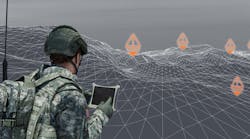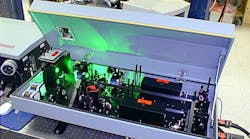by J.R. Wilson
SANTA CLARA, Calif. — WhereNet Corp. and the Illinois Institute of Technology Research Institute (IITRI) have announced a strategic relationship to develop tracking, identification, and security systems for homeland defense applications.
Researchers will demonstrate such applications, based on WhereNet's wireless Real-Time Locating System (RTLS) technology, with a campus-wide system at a 10-acre facility in Lanham, Md.
"Even before the events of Sept. 11th, IITRI and WhereNet believed in the potential for RTLS technology in government," says Andrew O'Neill, RTLS business manager for IITRI. "Given our proximity to Washington, D.C., we expect to host dozens of government dignitaries and decision-makers in early 2002 to introduce WhereNet's real-time locating systems, one of the key enabling technologies that will provide an additional layer of security at airports, military bases, and federal buildings, both domestically and abroad."
The WhereNet wireless locating and tracking technology uses special low-power radio frequency tags to locate items or individuals to within 10 feet and monitor their movements throughout a given coverage area. It also can integrate with other tracking, identification, and security applications such as motion detectors and video surveillance cameras.
IITRI's team of scientists, engineers, and technical personnel will use that as the base for developing solutions for critical technology problems, IITRI officials say.
They are looking into some future implementations such as integration into headsets, vehicles, test equipment, safety harnesses, and uniforms. WhereNet says the system is scalable from feet to miles of coverage, indoors and out, to simultaneously track thousands of people and objects and can be configured to define different levels of security zones and automatically trigger alarms.
WhereNet and IITRI propose the system could apply to a wide range of high-security uses, including:
- controlling access to sensitive and restricted areas (federal buildings, airports, HAZMAT environments, nuclear sites);
- locating and tracking individuals with specific skills or responsibilities, especially in crisis situations (medics, fire and rescue, police, security, mechanics, baggage handlers);
- identifying, reviewing and analyzing the "trail" of a person, group or asset before, during and after any unauthorized activity (for example, if the prescribed trail for a baggage cart is to pass a security scanner and then proceed directly to a plane-side loader, the RTLS system can either confirm that or raise an alert if procedure is violated); and
- managing large numbers of critical personnel and valuable assets under severe conditions (smoke, fog, fire, darkness) and identifying tagged personnel and non-tagged intruders.
"By leveraging IITRI's technical engineering staff, combined with WhereNet's technology, we will jointly bring to market next-generation security applications powered by WhereNet," says Matt Armanino, vice president of business development for WhereNet. "Our technology can provide a significant additional layer of security in airport and military environments. Through IITRI, we will unlock the tremendous potential for location-based security applications."


